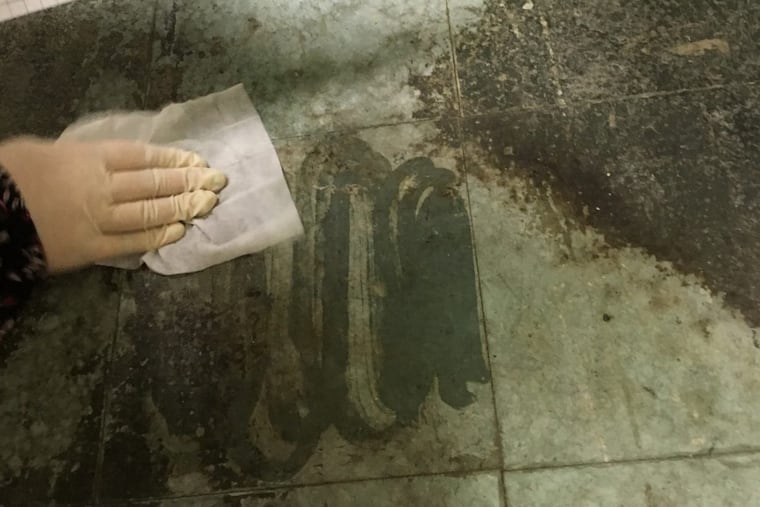How we did the testing
How Philadelphia investigative reporters collected dust samples at district schools to test for mold, lead and asbestos.

In early fall 2017, reporters decided to independently test the environmental conditions inside some of Philadelphia's most rundown district schools built before 1978, the year of the federal lead-paint ban. We used district maintenance documents and other records to create the list of schools.
We then began reaching out to teachers and building staffers to ask if they would help us test for four health hazards: Mold, asbestos fibers, lead dust and lead in drinking water.
To test drinking water for lead, we purchased sterile water collection bottles from a firm that sells environmental testing equipment. We later learned that it was easier and just as reliable for staffers to draw a water samples from fountain taps using their own empty water bottles.
We did not precisely follow federal and state guidelines for testing water for lead. Those guidelines say testers should collect "first draw" samples, water that sat overnight in pipes. That sample should be followed up with a "second draw" after the water has run for a bit. Instead, we instructed staffers to simply press their thumb on the taps of drinking fountains and fill their containers, labeling the bottles by school name, fountain location, date and time of water draw. We did not witness the testing firsthand.
We picked up samples of water from staffers and delivered them to a state-certified lab. We used International Asbestos Testing Laboratories (iATL) in Mount Laurel, N.J., to do the lead analysis.
To test for lead in dust on surfaces inside schools, we purchased "Ghost Wipes," which met standards set by the American Society for Testing and Materials (ASTM). The wipes are premoistened with deionized water and come in individually sealed packets. The wipes, after one use, were put in 50 ml "Digestion Vessels" — EPA-approved collection bottles that provide greater chemical resistance.
Reporters were taught at a state-certified lab how to collect dust-wipe samples using approved scientific methods. A lab technician demonstrated how to use a grid to frame out a 12-by-12-inch square and then methodically wipe within that space. Reporters used those techniques to test for lead in dust in the "Toxic City: Tainted Soil" installment of the series.
We applied that knowledge and wrote out step-by-step instructions that was provided to school staffers. We also provided staffers with testing kits that included the written instructions, a permanent black-ink marker, several digestion vessels, and Ghost Wipes. We did not witness the testing.
We also did not require staffers to tape down 12-by-12-inch templates, but rather to try their best to measure that amount of surface space. Some school staffers chose to wear disposable gloves during the testing. The samples were tested at iATL, the New Jersey lab.
We used the same testing equipment — Ghost Wipes and EPA-approved collection tubes — to test for asbestos fibers in settled dust. There are no federal regulations for testing fibers in surface dust. But there are guidelines. They call for wiping a surface space of 10-by-10 centimeters, roughly a 4-by-4-inch square. We created a different set of written instructions for asbestos collection. We opted to test the material using Transmission Electron Microscopy (TEM), which has the ability to detect very small asbestos fibers.
Environmental scientists consider dust-wipe sampling to be an investigative tool to indicate potential airborne exposure. The Environmental Protection Agency, for example, used dust-wipes to gauge the scope of asbestos contamination in the wake of the September 11, 2001, collapse of the World Trade Center. Scientists and industrial hygienists say that any wipe samples that exceed 100,000 fibers (structures) per square centimeter (cm2) are cause for concern and indicate a potential fiber release.
Asbestos fibers are only dangerous when inhaled. The only way to measure airborne asbestos is to collect air samples. Under city and federal law, the School District of Philadelphia is required to monitor the air during and after an asbestos abatement job.
School district officials took issue with the newspapers' testing. Because we did not witness the testing, they said the chain-of-custody could not be confirmed. Also, the testing was not done by a certified environmental expert, the district noted.
In addition, Gerald Junod, the district's environmental manager, said that if the staffer inadvertently wiped an area larger than 4-by-4-inches, the results could be falsely elevated.
To collect mold spore samples, school staffers used one of two methods: The "Ghost Wipes" method described above. The other is called a "tape grab," placing a piece of clear tape against a spot of suspected mold. Staffers then pressed the tape on a glass slide, then numbered each slide with a marker. They wrote down sample location and noted the corresponding slide number. For example: Slide 1, back wall, classroom number, near window.
The staffers placed the slides in a plastic case with dividers so the slides didn't touch.